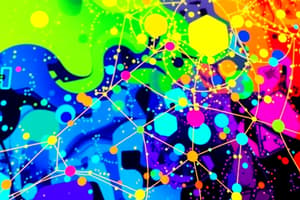Podcast
Questions and Answers
ما هي الأنظمة الموزعة؟
ما هي الأنظمة الموزعة؟
نمط من تصميم الأنظمة الحاسوبية يتكون من عدد أجزاء أو عقد متصلة ببعضها عبر شبكة وتعمل كنظام واحد متكامل.
ما هي إحدى مزايا الأنظمة الموزعة؟
ما هي إحدى مزايا الأنظمة الموزعة؟
- التحمل العالي للأعباء (correct)
- تعزيز الأداء فقط عند فشل النظام
- توقف النظام عند فشل جزء واحد
- عدم إمكانية التوسع
ما هو مفهوم Middleware؟
ما هو مفهوم Middleware؟
البرامج الوسيطة التي تربط بين العميل والخادم وتوفر تواصل وتفاعل بين التطبيقات والمكونات المختلفة.
ما الذي توفره Middleware عادةً؟
ما الذي توفره Middleware عادةً؟
النظام الموزع هو نظام تتوضع فيه المكونات على حواسيب متعددة متصلة عبر _____ .
النظام الموزع هو نظام تتوضع فيه المكونات على حواسيب متعددة متصلة عبر _____ .
يمكن إضافة أجزاء جديدة إلى النظام الموزع بسهولة.
يمكن إضافة أجزاء جديدة إلى النظام الموزع بسهولة.
في حالة حدوث خطأ، ماذا يحدث للأجزاء الأخرى في النظام الموزع؟
في حالة حدوث خطأ، ماذا يحدث للأجزاء الأخرى في النظام الموزع؟
ما هي الأنظمة الموزعة؟
ما هي الأنظمة الموزعة؟
ما هي إحدى مزايا الأنظمة الموزعة؟
ما هي إحدى مزايا الأنظمة الموزعة؟
ما هو برنامج الـ Middleware؟
ما هو برنامج الـ Middleware؟
ما هي وظيفة الـ Middleware؟
ما هي وظيفة الـ Middleware؟
الأنظمة الموزعة تتطلب دائمًا وجود شبكة واحدة متصلة.
الأنظمة الموزعة تتطلب دائمًا وجود شبكة واحدة متصلة.
ما هي إحدى التطبيقات الشائعة للأنظمة الموزعة؟
ما هي إحدى التطبيقات الشائعة للأنظمة الموزعة؟
Flashcards
Distributed Systems
Distributed Systems
A system composed of interconnected nodes or computers, where tasks and responsibilities are distributed across these connected components, working together as an integrated system.
Distributed System Models
Distributed System Models
Different ways of designing and structuring distributed systems to achieve specific functionality or resource utilization.
Cloud Computing
Cloud Computing
Computing resources (like servers and storage) provided as a service over the internet.
Virtualization
Virtualization
Signup and view all the flashcards
Clustering
Clustering
Signup and view all the flashcards
Service Oriented Architecture (SOA)
Service Oriented Architecture (SOA)
Signup and view all the flashcards
Cloud Programming
Cloud Programming
Signup and view all the flashcards
Grid Computing
Grid Computing
Signup and view all the flashcards
Peer-to-Peer Computing (P2P)
Peer-to-Peer Computing (P2P)
Signup and view all the flashcards
Middleware
Middleware
Signup and view all the flashcards
Load Balancing
Load Balancing
Signup and view all the flashcards
Scalability
Scalability
Signup and view all the flashcards
Reliability
Reliability
Signup and view all the flashcards
Session Management
Session Management
Signup and view all the flashcards
Error Handling
Error Handling
Signup and view all the flashcards
Data Transformation
Data Transformation
Signup and view all the flashcards
Distributed Systems
Distributed Systems
Signup and view all the flashcards
Middleware
Middleware
Signup and view all the flashcards
Load Balancing
Load Balancing
Signup and view all the flashcards
Scalability
Scalability
Signup and view all the flashcards
Reliability
Reliability
Signup and view all the flashcards
Distributed System Models
Distributed System Models
Signup and view all the flashcards
Independent Components
Independent Components
Signup and view all the flashcards
Integrated System
Integrated System
Signup and view all the flashcards
Network
Network
Signup and view all the flashcards
Shared Tasks/Responsibilities
Shared Tasks/Responsibilities
Signup and view all the flashcards
Error Handling
Error Handling
Signup and view all the flashcards
Session Management
Session Management
Signup and view all the flashcards
Data Transformation
Data Transformation
Signup and view all the flashcards
Networked Components
Networked Components
Signup and view all the flashcards
Common Goals
Common Goals
Signup and view all the flashcards
Study Notes
Distributed Systems
- Distributed systems are a type of computer system design composed of multiple interconnected devices or nodes linked via a network.
- Tasks and responsibilities are distributed among these connected devices.
- They work together as a single integrated system.
- A distributed system is a software system in which different components reside on multiple, physically separate computers connected across a network.
- These components interact and coordinate their activities through message passing.
Distributed Systems and Parallel Processing
- Key concepts include: Cloud Computing, Virtualization, Clustering, Distributed System Models, Cloud Programming, Service Oriented Architecture, Grid Computing, and Peer-to-Peer Computing.
Distributed System (Introduction)
- Distributed systems are designed to be highly efficient and use resources from multiple interconnected devices.
- They are characterized by significant advantages including load balancing, fault tolerance, scalability, and resource utilization.
Distributed Systems Definition
- Distributed systems consist of multiple independent computers connected via a computer network.
- These computers collaborate to achieve a common goal.
- These computers appear to act as a unified system.
- Data and task management are distributed across multiple connected machines.
Advantages of Distributed Systems
- Load balance and redundancy: Distributing work across multiple computers can manage and maintain a balance in the system. This improves performance and response time.
- Fault tolerance: If one computer fails, the other computers in the system can continue to function and provide services, significantly increasing the system's stability and flexibility.
- Scalability: Adding more computers to a distributed system easily expands capacity and resources. This enables the system to grow and handle increased workloads without disrupting service.
- Use of distributed resources: Distributed systems can utilize various resources including memory, processing units, and distributed databases which allows for better performance of applications and processing of large datasets.
Key Aspects of Distributed Systems
- Independent computers
- Unified system (Middleware)
Middleware
- Middleware software works between two or more programs to translate information between them or connect them.
- It resides between application software and the operating system or network operating system, or database management system.
- Middleware acts as an intermediary layer to facilitate communication and interaction between applications and other components in the system.
Middleware Functions
- Session Management
- Security
- Data Transformation
- Error Handling
- Communication
- Service Administration
Distributed System Architecture
- Layers of functionality are designed to enhance how the parts of a system interact and communicate to achieve a common goal, improving overall performance and preventing bottlenecks.
- This architecture allows for scalability and flexibility in accommodating multiple interconnected devices.
- The distributed system architecture is based on several layers, each with a specific function, such as data management, communication, and application layers. The network layer connects the different hardware elements.
Distributed System Characteristics
- Transparency
- Flexibility
- Reliability
- Performance
- Scalability
- Heterogeneity
- Security
- Failure handling
- Openness
- Concurrency
- Consistency
- Resource Sharing
Transparency
- Hiding details (location, structure, and functioning of system components) for user
- Making it seem as if the system is one singular unit
- User awareness of the dispersed nature of the system is not needed for proper functioning.
- The system must be able to handle the interaction between software and hardware components, ensuring it can handle failure from any part without complete system shutdown.
Distributed Systems Applications
- Social networks
- High-traffic websites
- Online banking systems (e-banking)
- Online gaming platforms
- Distributed Databases and Data Warehouses
- Distributed Information Systems
- Collaborative Design and Modeling Applications
Distributed Computing System
- Independent computers are connected to a shared network to provide a shared computing environment.
- Multiple computers collaborate similarly to one big computer.
Scalability
- The ability of a system to handle more user access and more data as the system expands.
Heterogeneity
- The ability of a system to work with a variety of software and hardware components, without problems with integration.
Failure Handling
- A system's ability to keep working even if there are partial failures of devices or software.
Other aspects of Distributed Systems
- Load Balancing: Distributing tasks fairly to different resources.
- Rollback/Recovery: Saving checkpoints/snapshots to easily return if errors occur.
- Distributed Database: A database where data resides on dispersed computers across a network.
Distributed Computing system
- Multiple computers interconnected to achieve common goals through network.
- Each connected computer serves as both client and server, distributing tasks and providing data over the network.
Distributed Database Systems
- Distributed databases are comprised of databases distributed over different locations on a network.
- They combine database management systems with computer network technologies.
- Systems aim to control data access through a central system.
Distributed Pervasive Systems
- Distributed pervasive systems involve networked resources and services accessible across different devices and locations .
- These resources offer a range of integrated computing services including storage, processing, and messaging capabilities, often operating independently while presenting a unified view to users.
- The user experience is simplified and they don't need to oversee the multiple locations where the resources exist.
Cloud Computing Principle
- Cloud computing focuses on accessing applications, data storage, and services through the internet, rather than requiring a dedicated system or device.
- The concept emphasizes the separation between user and resource, in contrast to running everything locally or via a dedicated server.
Client/Server Model
- This model involves a client (user) and server (computer), where requests are sent and responses are delivered.
- This model defines how an application is structured, which includes a distinct front-end interface for the user (client) and a back-end for data processing and storage (server).
- Separate parts of a task are performed on separate computers
- Requests from the user trigger specific tasks on the server.
Distributed Object Model
- It treats all devices interconnected in the network alike allowing them to function as clients and servers simultaneously.
Software Architecture (Different Models)
- Client/Server Model: The client sends requests to the server. The server responds. Data/result exchange occurs through a network.
- Distributed Object Model: This model assumes that all devices/computers are peers. They interact via a request/response architecture.
Application Layer
- This layer encompasses user interfaces that present data to the end user.
- This layer handles the program logic and processes required to present the data appropriately.
Client-Server Architecture Variations
- Two-tier: Primarily focuses on the client and the server.
- Three-tier: Enhances functionality by introducing an intermediate layer between client and server.
Distributed Operating System (DOS)
- A system that provides a unified view to users, while underlying elements are distributed and independent.
- Multiprocessor OS: Manages multiple processors within a single computer.
- Multicomputer OS: Manages resources from multiple computers interconnected in a network.
Network Operating System (NOS)
- A system intended to operate across a network, enabling computers to share resources and communicate.
- It's designed to handle heterogeneity and does not present a fully integrated view to users.
Studying That Suits You
Use AI to generate personalized quizzes and flashcards to suit your learning preferences.




